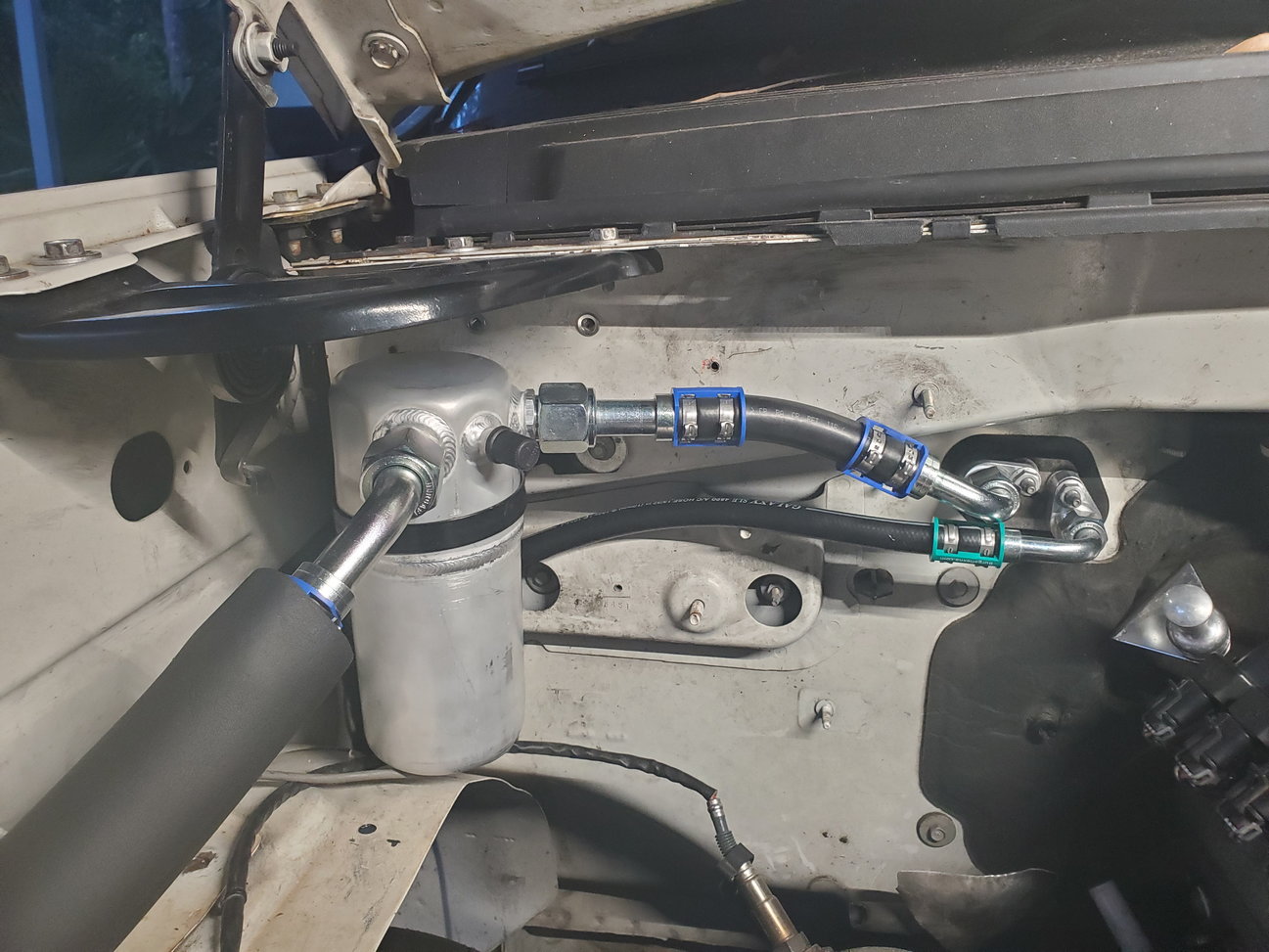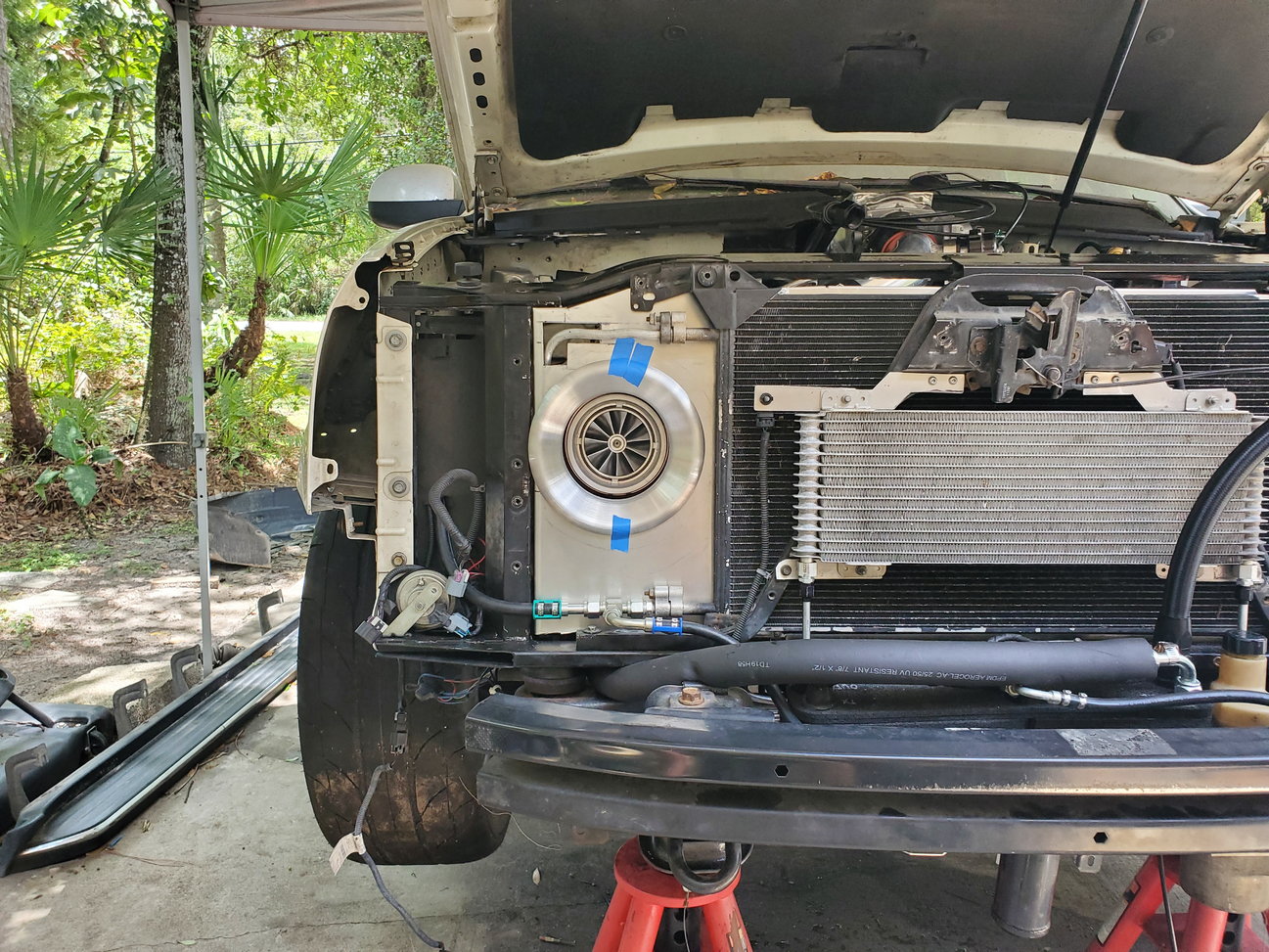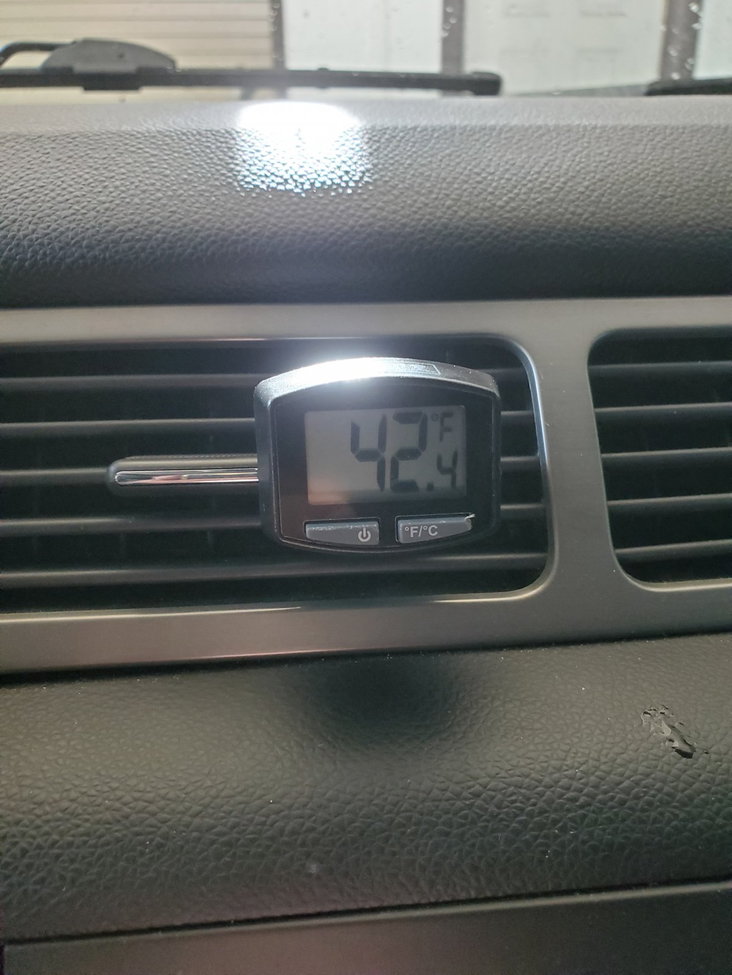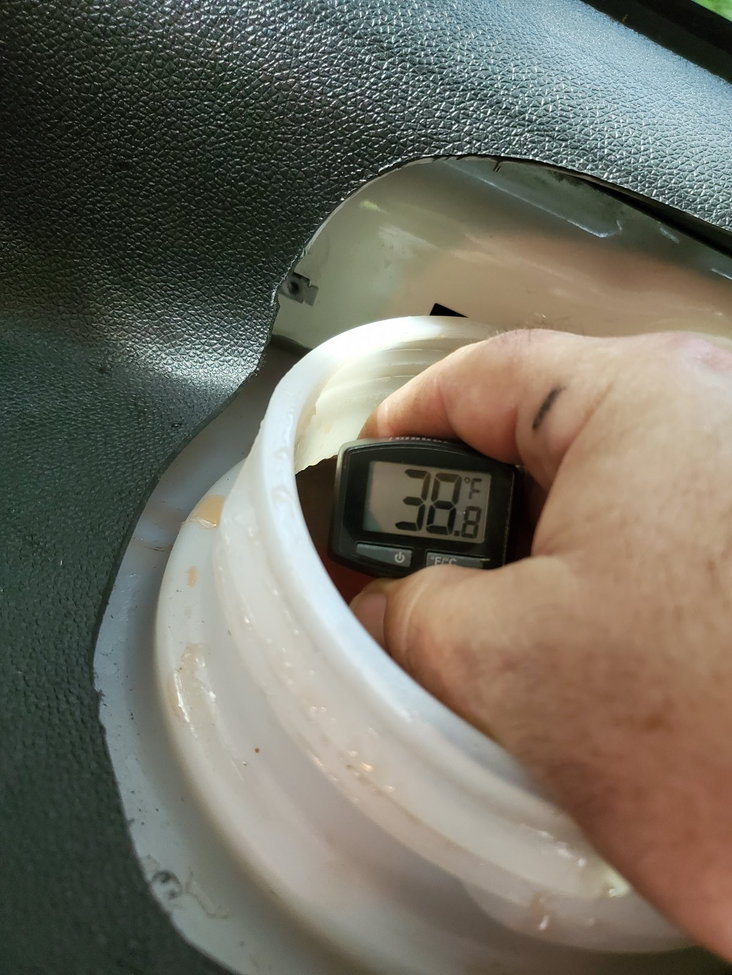2012 GMC Yukon AC + chiller mess
Moderators: bohica2xo, Tim, JohnHere
-
randeez
- Posts: 11
- Read the full article
- Joined: Wed Aug 25, 2021 12:25 pm
2012 GMC Yukon AC + chiller mess
Whats going on guys sorry for the novel,
I've got some problems, havent had much luck finding anyone that knows anything more than "put in it what the sticker says":
I will do my best to describe but most likely you'll need some more info ive forgot/overlooked/dont know
truck came with orifice tube for front ac, TVX for rear and an accumulator. I have gutted the rear AC, moved and replaced the accumulator with a different one, and added a chiller set up for an air to water intercooler that also uses a TVX.
what is there now:
out of the compressor the high side hose has a small sealed drier(I think?) and a pressure sensor on it (stock) to the condenser (stock). right off the condenser i have installed a Tee fitting and split the high pressure line;
side 1 goes to a filter drier and then to the TXV on the chiller. low side line returns to Tee right at compressor inlet.
side 2 hits a solenoid to cut off refrigerant going to the cab, high side service port, thru a universal orifice tube & housing, to the cabin evaporator, then to an accumulator(r12 with 134a port adapter - it was set up for -10 o-ring fittings already) with low side service port and back to the previously mentioned Tee at the compressor.
I have messed with the charge of the system from one end to the other, slowly filling from undercharged.
strictly filling with gauges leads to poor performance out of both the evap and chiller - however my service ports are only on the orifice tube side, i can read pressure directly after the compressor thru hptuners (and also command compressor to run) so im not real sure whats going on with the chiller
the best performance out of both systems leads to it being way over charged. IE charging it for lowest temps out of both systems. if the system is running i can continue to charge and get vent temps down in the low 40s (90* ambient) and chiller water temps near freezing. however after it sits and is started back up the compressor shuts off on high pressure 400psi+.
I guess what i am trying to find out is if this system is EVER going to work, is there some fatal flaw i should address > should i put a TVX on the cabin system and delete the low side accumulator? most of the GM fittings have been adapted to O-ring fittings i used -8 barrier hose for most of the high side, i dont know if dropping it down to -6 would make a difference? or I could swap most of it to hard lines? the low side is mostly -12 hose with -10 fittings.
i dont know if the accumulator and drier are just cycling refrigerant between them or what. but it seems that its never been consistent - unless ive left them both performing poorly.
I've got some problems, havent had much luck finding anyone that knows anything more than "put in it what the sticker says":
I will do my best to describe but most likely you'll need some more info ive forgot/overlooked/dont know
truck came with orifice tube for front ac, TVX for rear and an accumulator. I have gutted the rear AC, moved and replaced the accumulator with a different one, and added a chiller set up for an air to water intercooler that also uses a TVX.
what is there now:
out of the compressor the high side hose has a small sealed drier(I think?) and a pressure sensor on it (stock) to the condenser (stock). right off the condenser i have installed a Tee fitting and split the high pressure line;
side 1 goes to a filter drier and then to the TXV on the chiller. low side line returns to Tee right at compressor inlet.
side 2 hits a solenoid to cut off refrigerant going to the cab, high side service port, thru a universal orifice tube & housing, to the cabin evaporator, then to an accumulator(r12 with 134a port adapter - it was set up for -10 o-ring fittings already) with low side service port and back to the previously mentioned Tee at the compressor.
I have messed with the charge of the system from one end to the other, slowly filling from undercharged.
strictly filling with gauges leads to poor performance out of both the evap and chiller - however my service ports are only on the orifice tube side, i can read pressure directly after the compressor thru hptuners (and also command compressor to run) so im not real sure whats going on with the chiller
the best performance out of both systems leads to it being way over charged. IE charging it for lowest temps out of both systems. if the system is running i can continue to charge and get vent temps down in the low 40s (90* ambient) and chiller water temps near freezing. however after it sits and is started back up the compressor shuts off on high pressure 400psi+.
I guess what i am trying to find out is if this system is EVER going to work, is there some fatal flaw i should address > should i put a TVX on the cabin system and delete the low side accumulator? most of the GM fittings have been adapted to O-ring fittings i used -8 barrier hose for most of the high side, i dont know if dropping it down to -6 would make a difference? or I could swap most of it to hard lines? the low side is mostly -12 hose with -10 fittings.
i dont know if the accumulator and drier are just cycling refrigerant between them or what. but it seems that its never been consistent - unless ive left them both performing poorly.
Re: 2012 GMC Yukon AC + chiller mess
We had a 2005 GMC Yukon from 2010 through early summer; I did replace the compressor once due to slugging and compressor belt breakage. AC worked very well, Arizona desert, sold it at 235K miles. Yes, front orifice tube and rear TXV, that's how GM does this.
So a couple of months ago we picked up a 2011 Yukon, same type of AC system, also works real well.
So I ask: why not do as GM designed, works well enough !!!
So a couple of months ago we picked up a 2011 Yukon, same type of AC system, also works real well.
So I ask: why not do as GM designed, works well enough !!!
-
tbirdtbird
- Preferred Member
- Posts: 1448
- Joined: Sat May 02, 2020 1:48 pm
- Location: Texas
Re: 2012 GMC Yukon AC + chiller mess
He "added a chiller set up for an air to water intercooler" after ripping out the rear system
whatever that is
whatever that is
When considering your next auto A/C purchase, please consider the site that supports you: www.ACKits.com
Re: 2012 GMC Yukon AC + chiller mess
Ok, let's sort out the OEM components from the changes first.
The original Front / Rear GM system had a hard line from the condenser with a T in it to feed the rear evaporator TXV. It did not include a receiver / dryer for the rear TXV, but relied on the 8 feet of line to the back of the vehicle for that job.
The front or dashboard evaporator is fed by a simple orifice tube, and uses an engine bay mounted accumulator. It operates as a CCOT system even though there is a TXV in the rear circuit.
The "small sealed drier" in the compressor discharge line is actually a muffler of sorts. The pressure sensor checks the discharge pressure before the condenser.
So you moved the rear evaporator, and replaced the condenser discharge line - is the rear evaporator now under the hood?
Apparently you made several changes to the front evaporator as well. Relocated the orifice tube, the accumulator and added a solenoid valve?
Hard to visualize without more information. A picture would be helpful
I have done the secondary chiller for an intercooler before. Much smaller scale, a SAAB 900 Turbo. It worked ok, but took some fiddling to get right. In the end I was circulating several gallons of an antifreeze mixture held around 25f
Let's fill in some more info before I make specific recommendations.
What sort of temperature are you looking for in the liquid for the charge cooler loop? How much liquid are you holding / buffering? Or are you trying to use the evaporator directly as a charge cooler?
The original Front / Rear GM system had a hard line from the condenser with a T in it to feed the rear evaporator TXV. It did not include a receiver / dryer for the rear TXV, but relied on the 8 feet of line to the back of the vehicle for that job.
The front or dashboard evaporator is fed by a simple orifice tube, and uses an engine bay mounted accumulator. It operates as a CCOT system even though there is a TXV in the rear circuit.
The "small sealed drier" in the compressor discharge line is actually a muffler of sorts. The pressure sensor checks the discharge pressure before the condenser.
So you moved the rear evaporator, and replaced the condenser discharge line - is the rear evaporator now under the hood?
Apparently you made several changes to the front evaporator as well. Relocated the orifice tube, the accumulator and added a solenoid valve?
Hard to visualize without more information. A picture would be helpful
I have done the secondary chiller for an intercooler before. Much smaller scale, a SAAB 900 Turbo. It worked ok, but took some fiddling to get right. In the end I was circulating several gallons of an antifreeze mixture held around 25f
Let's fill in some more info before I make specific recommendations.
What sort of temperature are you looking for in the liquid for the charge cooler loop? How much liquid are you holding / buffering? Or are you trying to use the evaporator directly as a charge cooler?
Re: 2012 GMC Yukon AC + chiller mess
I know what this is, if this is a chilled water intercooler, Ford SVT was working on this in the early 2000s thinking of putting it in SVT Lightnings. I hope you get it working, it's a neat idea, for the record I really like stuff like this.
Agree with Bohica that pictures would help out a lot.
Where did you get the TXV for the chiller setup, have you adjusted it? How about the chiller evaporator? What is it?
Is your accumulator piped the right way? Into a dome, out of a J-tube, are you able to see these things or know from it's intended application which way it goes?
Stock compressor? 10S20 Denso?
When you have things running the best you can get, what are the temperatures like? Are some suction lines cold and sweaty, some not?
Where are you located? Ask your mom if you can bring it over so we can play with it.
Agree with Bohica that pictures would help out a lot.
Where did you get the TXV for the chiller setup, have you adjusted it? How about the chiller evaporator? What is it?
Is your accumulator piped the right way? Into a dome, out of a J-tube, are you able to see these things or know from it's intended application which way it goes?
Stock compressor? 10S20 Denso?
When you have things running the best you can get, what are the temperatures like? Are some suction lines cold and sweaty, some not?
Where are you located? Ask your mom if you can bring it over so we can play with it.
Re: 2012 GMC Yukon AC + chiller mess
thanks for the clarification bohica2xo, the rear ac system is completely gone. temp of the chiller coolant i would like sub freezing honestly but anything below 50* will yield me nice intake temps
detroitAC, I am nearly certain the accumulator is piped correctly. i am going to replace the condenser soon to rule it out so i will double check while it is evacuated.
correct, the chiller cools water to be circulated through and air to water intercooler, guys usually run a water/ice box to drop intake temps. the chiller will maintain near freezing coolant (antifreeze) at all times. probably has total capacity of about 10 gallons. i also have a pwm controlled pump on it so i can very the flow/heat load - not sure if i should just pick a static value and leave it there to simplify the whole deal.
south florida - dumping a bag of ice into 95* ambient water lasts about 5 minutes, and i would like to keep ac, cause why not?
the chiller, txv, drier, some hose and fittings were all provided by a company that usually deals with factory blower cars (ctsv, zl1, hellcats,etc) so this is more of a universal install. i have changed some of the hoses, fittings as ive re-routed them to accommodate this mess
stock compressor denso 10s20
pics below of vent and coolant temps are what i can get it down to, but after i shut it off and let it all sit. next time i jump in it it floods the compressor and has high pressure problems.
gimme a sec for pics, doesnt like site i grabbed them from
detroitAC, I am nearly certain the accumulator is piped correctly. i am going to replace the condenser soon to rule it out so i will double check while it is evacuated.
correct, the chiller cools water to be circulated through and air to water intercooler, guys usually run a water/ice box to drop intake temps. the chiller will maintain near freezing coolant (antifreeze) at all times. probably has total capacity of about 10 gallons. i also have a pwm controlled pump on it so i can very the flow/heat load - not sure if i should just pick a static value and leave it there to simplify the whole deal.
south florida - dumping a bag of ice into 95* ambient water lasts about 5 minutes, and i would like to keep ac, cause why not?
the chiller, txv, drier, some hose and fittings were all provided by a company that usually deals with factory blower cars (ctsv, zl1, hellcats,etc) so this is more of a universal install. i have changed some of the hoses, fittings as ive re-routed them to accommodate this mess
stock compressor denso 10s20
pics below of vent and coolant temps are what i can get it down to, but after i shut it off and let it all sit. next time i jump in it it floods the compressor and has high pressure problems.
gimme a sec for pics, doesnt like site i grabbed them from
Last edited by randeez on Wed Aug 25, 2021 7:11 pm, edited 1 time in total.
Re: 2012 GMC Yukon AC + chiller mess
the ac compressor is lower passengerside mounted on the engine, the low side hoses are insulated. there is a few inches of between all of the turbo hot side. all of the exhaust will end up with a blanket or exhaust wrap on it. and I ordered a pusher fan to throw in front of the condenser to help with shedding the heat
Re: 2012 GMC Yukon AC + chiller mess
Yeah, I'm curious what the chiller evaporator is, but I'll tell you just knee jerk what I think is going on.
During shutdown the chiller and maybe also the reservoir of cold water are the coldest spot by far in the whole system, they are going to fill up as much as they can with liquid refrigerant, the entire chiller (whatever it is) and all the piping that is kept cold by the reservoir water, completely full of liquid.
When you startup there is no buffer of any kind between all this liquid and the suction port of the compressor. The liquid is going to flash almost all at once and send a huge slug of liquid into the compressor. I've seen many cars have this kind of problem, Econoline vans with big 115cc scrolls were regularly snapping their compressor shafts from this kind of slugging. All of this liquid going all of a sudden to the condenser just fills it up and prevents condensing, probably very high pressure and very high subcooling. Dodge Neon would also do this, could go from 200 psig to 550 psig in the condenser in like 1/2 second, and pop the PRV.
One solution is to do what commercial refrigeration systems do, they have very similar problems since evaporator coils inside something like a refrigerated warehouse are always cold and would fill up if not controlled. It's called a pumpdown cycle, you could probably Google that. You need to evacuate somewhat the refrigerant from the chiller before you shut down, to do this you would have to have a receiver that can hold the extra charge amount that normally exist in the operating chiller. You would shut off the solenoid valve to the chiller and let the compressor run for maybe a minute or two to pull all the charge out. you would also need a check valve in the suction line since refrigerant from the entire circuit is still able to flow in through the accumulator, orifice tube, suction line, etc.
You could also put an additional accumulator downstream of the chiller just to handle the startup slug of liquid, commercial guys also install accumulators like this just for these nasty transient things.
You could also run dual TXV with dual solenoids and run a pumpdown, no need for a check valve that way since you can dry out the low side and the compressor reed valves will keep refrigerant all on the high side, need an adequate sized receiver also in this case.
During shutdown the chiller and maybe also the reservoir of cold water are the coldest spot by far in the whole system, they are going to fill up as much as they can with liquid refrigerant, the entire chiller (whatever it is) and all the piping that is kept cold by the reservoir water, completely full of liquid.
When you startup there is no buffer of any kind between all this liquid and the suction port of the compressor. The liquid is going to flash almost all at once and send a huge slug of liquid into the compressor. I've seen many cars have this kind of problem, Econoline vans with big 115cc scrolls were regularly snapping their compressor shafts from this kind of slugging. All of this liquid going all of a sudden to the condenser just fills it up and prevents condensing, probably very high pressure and very high subcooling. Dodge Neon would also do this, could go from 200 psig to 550 psig in the condenser in like 1/2 second, and pop the PRV.
One solution is to do what commercial refrigeration systems do, they have very similar problems since evaporator coils inside something like a refrigerated warehouse are always cold and would fill up if not controlled. It's called a pumpdown cycle, you could probably Google that. You need to evacuate somewhat the refrigerant from the chiller before you shut down, to do this you would have to have a receiver that can hold the extra charge amount that normally exist in the operating chiller. You would shut off the solenoid valve to the chiller and let the compressor run for maybe a minute or two to pull all the charge out. you would also need a check valve in the suction line since refrigerant from the entire circuit is still able to flow in through the accumulator, orifice tube, suction line, etc.
You could also put an additional accumulator downstream of the chiller just to handle the startup slug of liquid, commercial guys also install accumulators like this just for these nasty transient things.
You could also run dual TXV with dual solenoids and run a pumpdown, no need for a check valve that way since you can dry out the low side and the compressor reed valves will keep refrigerant all on the high side, need an adequate sized receiver also in this case.



